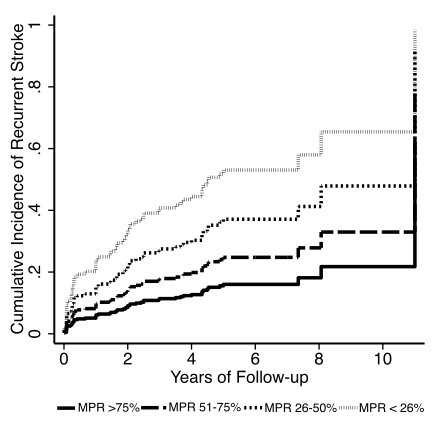Final ID: WP154
Suboptimal Medication Possession Ratio is Associated with Increased Recurrent Ischemic Stroke Risk in a Veteran Population
Abstract Body: Objectives:
Recurrent stroke results in higher disability and mortality but might be mitigated through interventions that improve medication adherence. The medication possession ratio (MPR) is an objective proxy for adherence that may provide individualized risk assessment for recurrent stroke.
Methods:
This is a retrospective, longitudinal cohort study of patients with recent ischemic stroke or TIA referred to a Veterans Affairs vascular neurology clinic between 2010 and 2016. Through review of pharmacy and medical records over the years after incident ischemic event, we calculated average MPR quartile for four stroke-preventative medication classes. Traditional stroke risk factors were quantified using the Framingham Stroke Risk Profile (FSRP) score and TOAST stroke etiological classification was determined. We hypothesized that lower average MPR over all classes would relate to higher recurrent stroke risk more than FSRP or stroke etiology.
Results:
255 patients with stroke or TIA, (mean age 67 ±10 years; 95% male) had a median follow-up period of 5.0 years (IQR 2.0). MPRs during follow-up were similar across 4 medication classes (77.1% to 81.9%) and highly correlated (R2 0.20 to 0.50). On average, MPR decreased by 4.3% per year after stroke (95%CI: 0.5 to 8%, p=0.025). Recurrent stroke occurred in 57 (22.4%) patients at median 604 (IQR 993) days, with cumulative rates of 4.7%, 8.7%, 13.7%, and 24.5% at 90 days, 1 year, 2 years, and 5 years respectively. In survival analysis covarying for FSRP and accounting for the competing risk of death, each quartile lower for average MPR was associated with higher cumulative incidence of recurrent stroke (subhazard ratio 1.63, 95%CI: 1.24 to 2.14, p<0.001; Figure 1). Neither FSRP nor stroke etiology were associated with recurrent stroke. However, when individual FSRP components were considered, higher baseline systolic blood pressure (SHR 1.16 per 10 mmHg, 95%CI: 1.02 to 1.32, p=0.026) was also independently associated with stroke recurrence.
Conclusions:
MPR is an effective proxy for quantifying medication adherence to assess recurrent stroke risk. Systems-based and individualized interventions to improve adherence are needed to reduce recurrent stroke rates in VA populations.
Recurrent stroke results in higher disability and mortality but might be mitigated through interventions that improve medication adherence. The medication possession ratio (MPR) is an objective proxy for adherence that may provide individualized risk assessment for recurrent stroke.
Methods:
This is a retrospective, longitudinal cohort study of patients with recent ischemic stroke or TIA referred to a Veterans Affairs vascular neurology clinic between 2010 and 2016. Through review of pharmacy and medical records over the years after incident ischemic event, we calculated average MPR quartile for four stroke-preventative medication classes. Traditional stroke risk factors were quantified using the Framingham Stroke Risk Profile (FSRP) score and TOAST stroke etiological classification was determined. We hypothesized that lower average MPR over all classes would relate to higher recurrent stroke risk more than FSRP or stroke etiology.
Results:
255 patients with stroke or TIA, (mean age 67 ±10 years; 95% male) had a median follow-up period of 5.0 years (IQR 2.0). MPRs during follow-up were similar across 4 medication classes (77.1% to 81.9%) and highly correlated (R2 0.20 to 0.50). On average, MPR decreased by 4.3% per year after stroke (95%CI: 0.5 to 8%, p=0.025). Recurrent stroke occurred in 57 (22.4%) patients at median 604 (IQR 993) days, with cumulative rates of 4.7%, 8.7%, 13.7%, and 24.5% at 90 days, 1 year, 2 years, and 5 years respectively. In survival analysis covarying for FSRP and accounting for the competing risk of death, each quartile lower for average MPR was associated with higher cumulative incidence of recurrent stroke (subhazard ratio 1.63, 95%CI: 1.24 to 2.14, p<0.001; Figure 1). Neither FSRP nor stroke etiology were associated with recurrent stroke. However, when individual FSRP components were considered, higher baseline systolic blood pressure (SHR 1.16 per 10 mmHg, 95%CI: 1.02 to 1.32, p=0.026) was also independently associated with stroke recurrence.
Conclusions:
MPR is an effective proxy for quantifying medication adherence to assess recurrent stroke risk. Systems-based and individualized interventions to improve adherence are needed to reduce recurrent stroke rates in VA populations.
More abstracts on this topic:
Adherence to Antihypertensive Medication Varies by Insurance Status in US Adults: The Behavior Risk Factor Surveillance System (BRFSS) Study (2019-2023)
Jurado Velez Javier, Hidalgo Bertha
A Case Series of Papillary Fibroelastomas on the Coumadin ridgeAboukhatwa Omar, Akiki Elias, Kurmann Reto, Larson Kathryn, Keeney Michael, Bois Melanie, Klarich Kyle
Readers' Comments
We encourage you to enter the discussion by posting your comments and questions below.
Presenters will be notified of your post so that they can respond as appropriate.
This discussion platform is provided to foster engagement, and simulate conversation and knowledge sharing.
You have to be authorized to post a comment. Please, Login or Signup.
Rate this abstract
(Maximum characters: 500)

